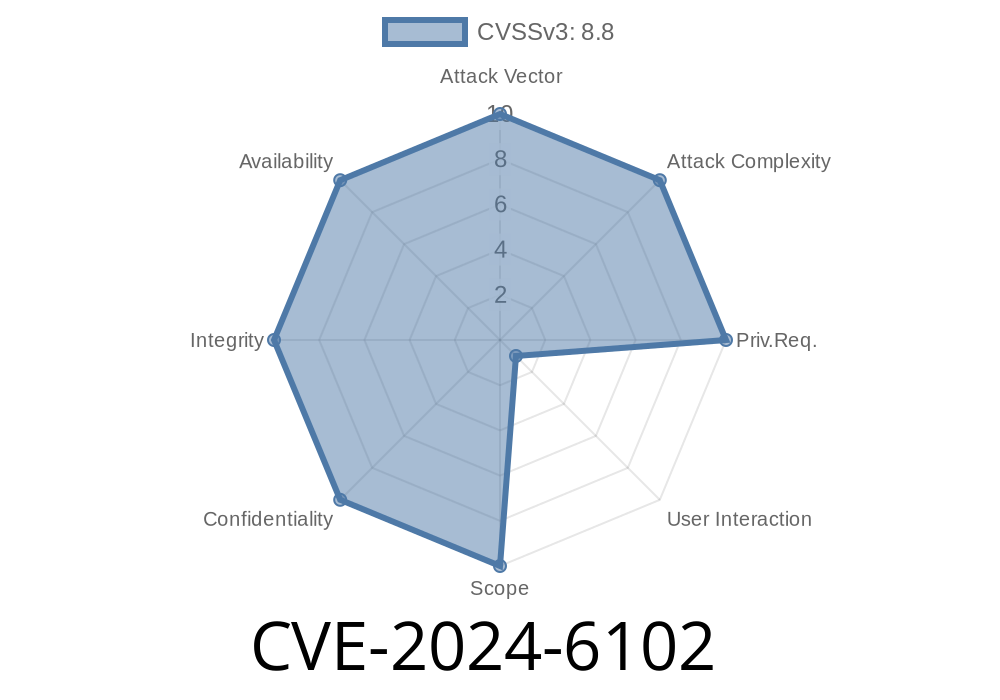In this article, we will dive into the details of the recent vulnerability reported in Google Chrome: CVE-2024-6102. This issue involves an out of bounds memory access in the WebGPU implementation named "Dawn" and affects Google Chrome versions before 126..6478.114. It is classified as a high-severity vulnerability by Chromium's security team and may potentially allow remote attackers to exploit heap corruption through the use of a specially crafted HTML page. To get a better understanding, let's explore this vulnerability in-depth, discover how it emerges, and learn how to mitigate it.
Background
Dawn is an open-source and cross-platform implementation of WebGPU aiming at native implementation for multiple platforms such as Windows, macOS, and Linux. It serves as an abstraction layer for low-level graphics APIs such as Vulkan, Metal, or Direct3D 12. Due to its nature, it has the potential to introduce security risks if not implemented correctly.
The Vulnerability: CVE-2024-6102
This vulnerability CVE-2024-6102 is caused due to an out of bounds memory access issue in the Dawn implementation of Google Chrome. An attacker could exploit this to cause heap corruption by luring a victim to a specially crafted HTML page.
Exploit Details
A crafted HTML page designed to trigger this vulnerability would likely create a WebGPU context, then manipulate the context in a way that causes the memory access violation. A snippet of such an attack may resemble this:
<!DOCTYPE html>
<html>
<head>
<script>
async function exploit() {
const adapter = await navigator.gpu.requestAdapter();
const device = await adapter.requestDevice();
// Craft malicious parameters to trigger out of bounds access
const badDescriptor = /* ... */;
// attempting to create a pipeline with the malicious descriptor
try {
const badPipeline = device.createComputePipeline(badDescriptor);
} catch (e) {
console.error("Exploit failed:", e);
}
}
</script>
</head>
<body onload="exploit()">
<h1>CVE-2024-6102 Exploit Example</h1>
</body>
</html>
Please note that this code snippet is a hypothetical example of how an attacker may attempt to exploit this vulnerability, and some parameters have been omitted for security purposes.
Mitigation
Google has already addressed this issue in Chrome version 126..6478.114, so updating your Chrome browser to the latest version is the best way to protect yourself from this vulnerability. As an end user, always ensure that you're running the most recent version of Chrome by visiting the browser's "About" page for automatic updates – found in the main menu under "Help -> About Google Chrome."
For web developers, it's crucial to understand the importance of validating user input and handling it securely. WebGPU, like any other API, carries inherent risks and must be used responsibly.
Here are some key resources for further reading
1. Chromium bug report detailing the vulnerability and its resolution.
2. Dawn project – the WebGPU implementation involved in this vulnerability.
3. WebGPU API documentation – a comprehensive resource to understand WebGPU and its usage.
Conclusion
CVE-2024-6102 serves as a reminder of the complex nature of web browsers and the potential security risks that come with them. By understanding the vulnerabilities and staying vigilant about updating your software, you lessen the chances of falling victim to exploits. In this case, simply updating Google Chrome to the latest version effectively mitigates the vulnerability.
As web developers and users, we must stay informed and take the necessary precautions to secure both ourselves and those who interact with our content. This article aimed to offer a deeper understanding of CVE-2024-6102 – the out of bounds memory access vulnerability in Dawn in Google Chrome – and showcased its exploit details, mitigation strategies, and relevant resources to enhance your knowledge about web security.
Timeline
Published on: 06/20/2024 00:15:10 UTC
Last modified on: 07/03/2024 02:09:42 UTC
